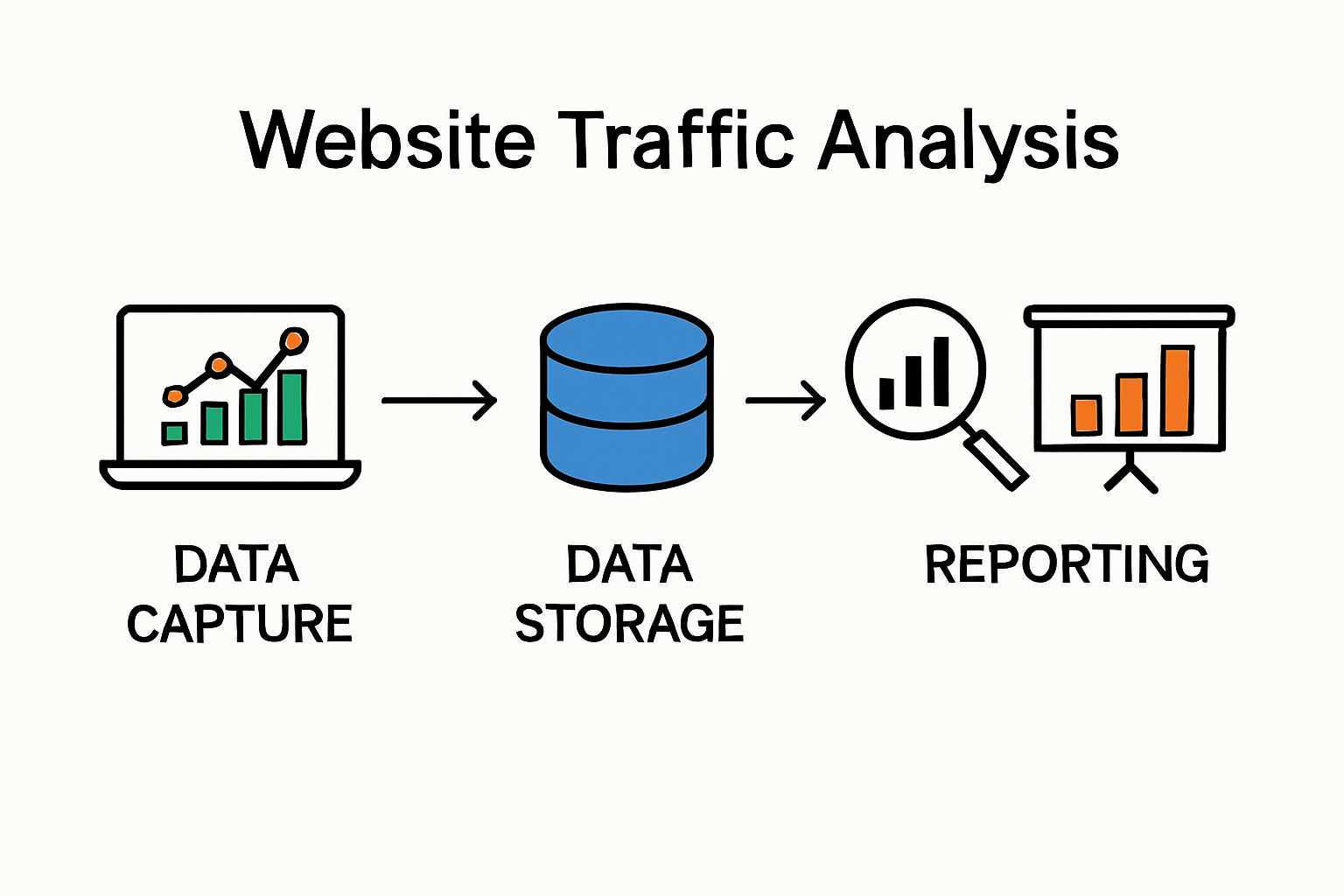Website Traffic Analysis for 2025: Boost Growth and ROI


Most businesses expect more website traffic to automatically mean more sales or leads. Surprise. Research shows that failing to segment traffic by device can hide massive gaps, such as a 10% conversion rate on desktops and only 1% on mobile. The real edge lies in what you do with the data—not just counting visitors, but analyzing their behaviors to turn those numbers into real growth.
Table of Contents
- Understanding Website Traffic Analysis Basics
- Top Tools For Accurate Traffic Insights
- Using Traffic Data To Improve Your Strategy
- Common Mistakes And How To Avoid Them
Quick Summary
| Takeaway | Explanation |
|---|---|
| Establish Clear Goals | Setting specific, measurable objectives is crucial for effective website traffic analysis, aligning analytics with overall business outcomes. |
| Utilize the Right Tools | Selecting powerful web analytics platforms like Google Analytics or specialized alternatives can enhance data collection and insights for better decision-making. |
| Analyze User Behavior | Understanding traffic patterns and demographic insights allows businesses to design targeted content strategies and improve user experience. |
| Avoid Common Pitfalls | Recognizing and mitigating errors in data collection, goal setting, and technical setup ensures that analytics yield accurate and actionable results. |
| Continuous Improvement | Traffic analysis should be an ongoing process, involving regular review and adaptation of strategies based on gathered insights to maintain competitiveness. |
Understanding Website Traffic Analysis Basics
Website traffic analysis is a strategic process that transforms raw digital data into actionable insights. Businesses leverage these insights to understand user behavior, optimize marketing strategies, and drive sustainable online growth. By systematically examining visitor interactions, organizations can make informed decisions that directly impact their digital performance.
The Core Components of Website Traffic Analysis
Effective website traffic analysis involves a structured four-stage methodology that enables comprehensive understanding of online visitor dynamics. According to academic research, this process encompasses four critical stages: data capture, data storage, data analysis, and reporting.
The first stage, data capture, involves collecting detailed information about website visitors. This includes tracking metrics such as page views, time spent on site, geographical location, device type, and navigation paths. Modern web analytics tools provide granular insights that go beyond simple visitor counts, offering a nuanced view of user engagement.
Data storage and subsequent analysis transform raw information into meaningful patterns. Advanced algorithms can identify trends, segment audiences, and highlight potential optimization opportunities. Research analyzing academic websites revealed that website size and content diversity play significant roles in attracting traffic, suggesting that comprehensive and varied content strategies are crucial.


Strategic Goal Setting in Traffic Analysis
Successful website traffic analysis requires clear, measurable objectives. Modern digital marketing experts emphasize that setting specific goals is fundamental to deriving value from web analytics. These goals might include increasing conversion rates, reducing bounce rates, improving user engagement, or expanding audience reach.Businesses should align their traffic analysis goals with broader organizational objectives. For instance, an e-commerce platform might focus on understanding conversion funnel performance, while a content-driven website might prioritize engagement metrics like average session duration and page depth.
Implementing Effective Traffic Analysis Strategies
Implementing a robust website traffic analysis framework involves selecting appropriate tools, establishing key performance indicators (KPIs), and developing a systematic approach to data interpretation. Google Analytics remains a popular choice, offering comprehensive tracking capabilities that can provide deep insights into website performance.
Key metrics to monitor include unique visitors, page views, bounce rate, average session duration, traffic sources, and conversion rates. By continuously tracking these indicators, businesses can make data driven decisions that enhance their online presence and user experience.
Moreover, traffic analysis is not a one-time activity but an ongoing process of measurement, learning, and optimization. Regular review and adaptation of strategies based on collected insights enable businesses to stay competitive in the dynamic digital landscape.
Successful website traffic analysis transforms complex data into clear, actionable strategies. By understanding visitor behavior, businesses can create more targeted, engaging online experiences that drive growth and success.
Top Tools for Accurate Traffic Insights
Accurate website traffic analysis depends on selecting powerful, feature-rich tools that provide comprehensive insights into digital performance. As digital landscapes become increasingly complex, businesses require sophisticated solutions that transform raw data into actionable intelligence.
Premier Web Analytics Platforms
Google Analytics remains the most widely used web analytics service globally, offering businesses an unparalleled suite of tracking and reporting capabilities. With its ability to provide granular insights into user behavior, traffic sources, and conversion metrics, this platform has become a cornerstone of digital strategy for organizations of all sizes.Beyond Google Analytics, alternative platforms offer unique advantages. Matomo, formerly known as Piwik, provides a privacy-focused alternative used by over a million websites. Its open-source nature allows for extensive customization and complete data ownership, addressing growing concerns about data privacy and third-party tracking.
Here is a table comparing the key features and advantages of the main web analytics platforms mentioned, to help readers quickly understand the differences:
| Analytics Platform | Key Features | Main Advantages |
|---|---|---|
| Google Analytics | User behavior, traffic sources, conversions | Widely used, free, robust |
| Matomo | Privacy focus, open source, customization | Complete data ownership, privacy-compliant |
| Adobe Analytics | AI insights, segmentation, behavior analysis | Enterprise features, predictive analytics |
| Mixpanel/Heap | Event tracking, intuitive, user friendly | Accessible, advanced analytics for SMEs |
Advanced Enterprise-Level Analytics Solutions
Adobe Analytics , part of the Adobe Experience Platform, represents a sophisticated option for businesses seeking comprehensive digital intelligence. Used by over 170,000 businesses, this platform delivers advanced features including:- AI-Driven Predictive Analytics: Leverages machine learning to forecast future user behaviors
- Robust Customer Segmentation: Enables precise targeting and personalization
- Automated Behavior Analysis: Provides insights based on complex user interaction patterns
Enterprise-level tools like Adobe Analytics go beyond basic traffic tracking, offering deep strategic insights that can transform digital marketing approaches. By understanding nuanced user interactions, businesses can develop more targeted and effective engagement strategies.
Emerging Tools and Specialized Tracking Solutions
The website traffic analysis landscape continues to evolve, with new tools emerging that address specific business needs. Specialized platforms now offer features like real-time heat mapping, user session recording, and advanced conversion funnel tracking.
Small to medium-sized businesses can leverage tools like Mixpanel and Heap, which provide intuitive interfaces and powerful analytical capabilities without requiring extensive technical expertise. These platforms democratize advanced web analytics, allowing organizations with limited resources to gain sophisticated insights.
When selecting a website traffic analysis tool, businesses should consider several critical factors:
- Compatibility with existing technology infrastructure
- Depth and granularity of available metrics
- Privacy and data security features
- Ease of implementation and use
- Cost-effectiveness and scalability
Effective website traffic analysis is not just about collecting data but transforming that data into strategic insights. The right tool can illuminate user behaviors, highlight optimization opportunities, and ultimately drive meaningful business growth. By carefully evaluating and selecting robust analytics platforms, organizations can unlock powerful strategies for digital success.
Using Traffic Data to Improve Your Strategy
Transforming website traffic data into strategic insights requires a systematic approach that goes beyond simple numerical analysis. Businesses can unlock powerful competitive advantages by understanding the nuanced patterns hidden within their digital interactions and visitor behaviors.
Strategic Traffic Pattern Analysis
Research examining web traffic distributions reveals sophisticated methods for understanding visitor engagement. By creating normalized traffic-fingerprints—24-dimensional vectors representing daily page traffic patterns—organizations can predict conversion rates and optimize online campaign strategies. These advanced analytical techniques can potentially increase online campaign revenue by over 50% through strategic page management.Understanding traffic patterns involves more than tracking visitor numbers. It requires deep comprehension of user navigation, engagement duration, and interaction quality. Analyzing how users move through a website provides critical insights into content effectiveness, user experience design, and potential optimization opportunities.
Demographic and Behavioral Insights
Academic research on website effectiveness highlights critical factors for improving user engagement. Key optimization strategies include:- Mobile Compatibility: Ensuring seamless experiences across different devices
- Media Optimization: Strategically designing images and videos for faster loading
- Demographic Understanding: Analyzing user characteristics and content access patterns
By segmenting traffic data, businesses can create more targeted content strategies. Understanding which demographic groups engage most with specific content allows for precise marketing and communication approaches.
To summarize the traffic optimization strategies discussed, here is a table outlining each strategy and its purpose:
| Optimization Strategy | Purpose |
|---|---|
| Mobile Compatibility | Seamless experiences on devices |
| Media Optimization | Faster loading through better media design |
| Demographic Understanding | Targeted content and marketing |
| Content Segmentation | Precise engagement for audience groups |
Advanced Navigation and User Experience Mapping
Social network analysis of website interactions offers profound insights into user navigation patterns. This sophisticated approach helps identify key user journey clusters and communication pathways, enabling businesses to design more intuitive website architectures.Effective traffic data utilization involves several strategic steps:
- Identify high-performing content and user pathways
- Recognize potential bottlenecks in user experience
- Develop targeted content based on observed user behaviors
- Continuously monitor and adapt website design
Successful strategy implementation requires ongoing analysis and adaptation. Traffic data is not a static resource but a dynamic tool for continuous improvement. Businesses that view their website as an evolving ecosystem can leverage traffic insights to create more engaging, user-centric digital experiences.
By combining advanced analytical techniques with a deep understanding of user behavior, organizations can transform raw traffic data into a powerful strategic asset. The key lies not just in collecting data, but in developing the capability to interpret and act upon these insights effectively.
Common Mistakes and How to Avoid Them
Website traffic analysis can be challenging, with numerous potential pitfalls that can undermine data accuracy and strategic decision-making. Understanding and avoiding these common mistakes is crucial for extracting meaningful insights and driving effective digital strategies.
Data Collection and Tracking Errors
Experts highlight that failing to segment website traffic by device type can significantly distort performance understanding. For example, a conversion rate of 10% on desktops compared to 1% on mobile devices reveals critical optimization needs that might otherwise go unnoticed.Another critical error involves improper tracking configuration. Many businesses inadvertently exclude important traffic sources or fail to filter out internal traffic, bot visits, and irrelevant user interactions. This can lead to inflated or misleading visitor metrics that do not represent genuine user engagement.
Research on web analytics reveals that overlooking cookie policy impacts can result in losing 40-50% of traffic data. Privacy regulations and user settings increasingly limit tracking capabilities, making it essential to implement robust, compliant analytics strategies that respect user preferences while maintaining data integrity.Goal Setting and Performance Measurement
Digital marketing professionals emphasize the importance of establishing clear, measurable objectives in web analytics. Businesses often make the critical mistake of collecting data without defining specific goals, rendering their analysis unfocused and ineffective.Key mistakes in goal setting include:
- Vague Objectives: Using broad, unmeasurable goals like "increase traffic"
- Misaligned Metrics: Tracking indicators that do not directly relate to business outcomes
- Inconsistent Measurement: Changing performance indicators frequently, preventing meaningful trend analysis
To avoid these pitfalls, businesses should develop SMART goals: Specific, Measurable, Achievable, Relevant, and Time-bound. This approach ensures that traffic analysis provides actionable insights aligned with strategic business objectives.
Technical and Analytical Limitations
Technical constraints can significantly impact the accuracy and usefulness of website traffic analysis. Common technical mistakes include:
- Improper implementation of tracking codes
- Failure to configure advanced segments
- Not setting up conversion funnels
- Overlooking cross-device user journeys
Addressing these limitations requires a comprehensive approach. Businesses should:
- Regularly audit their analytics setup
- Use multiple tracking tools for cross-verification
- Stay updated on emerging analytics technologies
- Invest in continuous staff training
Successful website traffic analysis is not about collecting the most data, but about collecting the right data and interpreting it intelligently. By recognizing and proactively addressing common mistakes, businesses can transform their approach to digital performance measurement.
Ultimately, effective traffic analysis is an ongoing process of learning, adaptation, and strategic refinement. Organizations that approach their data with critical thinking and a commitment to continuous improvement will gain the most valuable insights.
Frequently Asked Questions
What is website traffic analysis?
Website traffic analysis is the process of examining data related to website visitors to understand their behavior, interactions, and demographics. This analysis helps businesses optimize their online strategies for growth and increased ROI.
Why is it important to segment website traffic?
Segmentation allows businesses to identify differences in user behavior across devices, such as desktops versus mobile. This insight can reveal significant gaps, such as varying conversion rates, enabling more targeted strategies for improvement.
What tools are recommended for website traffic analysis?
Popular tools include Google Analytics for comprehensive tracking, Matomo for privacy-focused analytics, and Adobe Analytics for advanced enterprise-level insights. Tools like Mixpanel and Heap are also useful for small to medium-sized businesses.
How can traffic data improve online strategy?
By analyzing traffic patterns and user behavior, businesses can optimize content, enhance user experience, and fine-tune marketing strategies. This leads to increased engagement, higher conversion rates, and overall growth in online performance.
Ready to Turn Website Analysis Into Real Business Growth?
You have seen that analyzing your website traffic is only part of the journey. The real challenge is transforming those complex insights—such as identifying traffic gaps, low conversion rates, or missed mobile opportunities—into a steady stream of organic growth. Many businesses struggle to bridge this gap, often due to lack of time, expertise, or the overwhelming data to manage. This is where effective automation and proven strategy make all the difference.

Imagine shifting from scattered analytics to consistent, measurable results without the hassle. BabyLoveGrowth.ai does the heavy lifting for you, offering:
- Business and competitor analysis to pinpoint exactly what your audience wants
- A tailor-made 30-day content plan that addresses your unique website needs
- Automated, SEO-friendly articles that boost your search engine visibility and engage your visitors
Do not let another month of unoptimized website traffic hold back your business. Visit BabyLoveGrowth.ai now to see how AI-powered content can rapidly enhance your website’s performance. Get started today and experience the difference data-driven content can make.
Recommended
- SEO Trends for 2024: Key Shifts Every Marketer Should Know
- The Importance of Organic Traffic for Business Growth in 2025
- Proven Strategies for Organic Traffic Growth in 2025
- Converting Website Traffic: Proven Strategies for 2025
- How to Boost Website Speed in 2025: Proven Tips for SMBs & Marketers
- Blogging Tips for 2025: Proven Strategies for Growth
Smart SEO,
Faster Growth!
Most Read Articles

Generative Engine Optimization (GEO)
Learn how Generative Engine Optimization (GEO) helps your content rank in AI search engines like ChatGPT and Google AI. This comprehensive guide explains the differences between SEO and GEO, why it matters for your business, and practical steps to implement GEO strategies for better visibility in AI-generated responses.

Track LLM Traffic in Google Analytics 4 (GA4)
Learn how to track and analyze traffic from AI sources like ChatGPT, Claude, Perplexity, and Google Gemini in Google Analytics 4. This step-by-step guide shows you how to set up custom filters to monitor AI-driven traffic and make data-driven decisions for your content strategy.

How to Humanize AI Text with Instructions
Learn practical techniques to make AI-generated content sound more natural and human. This guide covers active voice, direct addressing, concise writing, and other proven strategies to transform robotic text into engaging content.

Open AI Revenue and Statistics (2024)
Comprehensive analysis of OpenAI financial performance, user engagement, and market position in 2023. Discover key statistics including $20B valuation, $1B projected revenue, and 100M+ monthly active users.